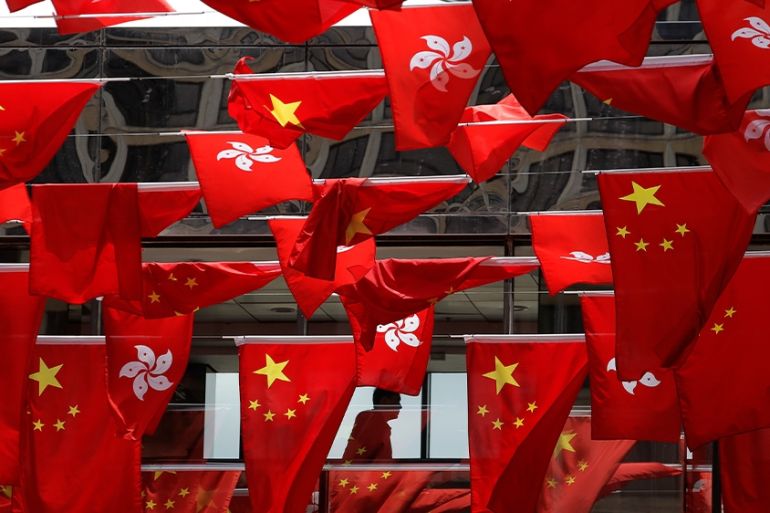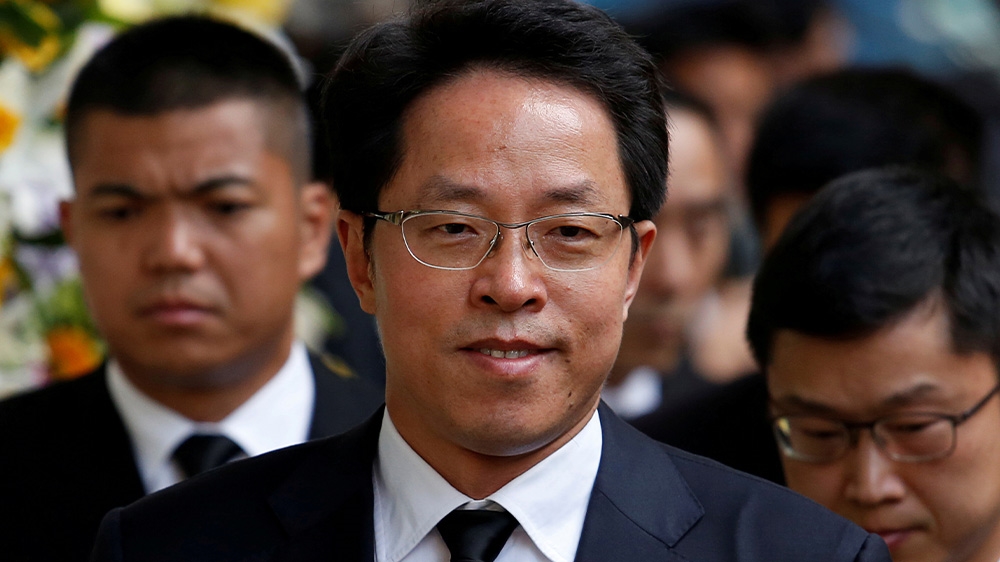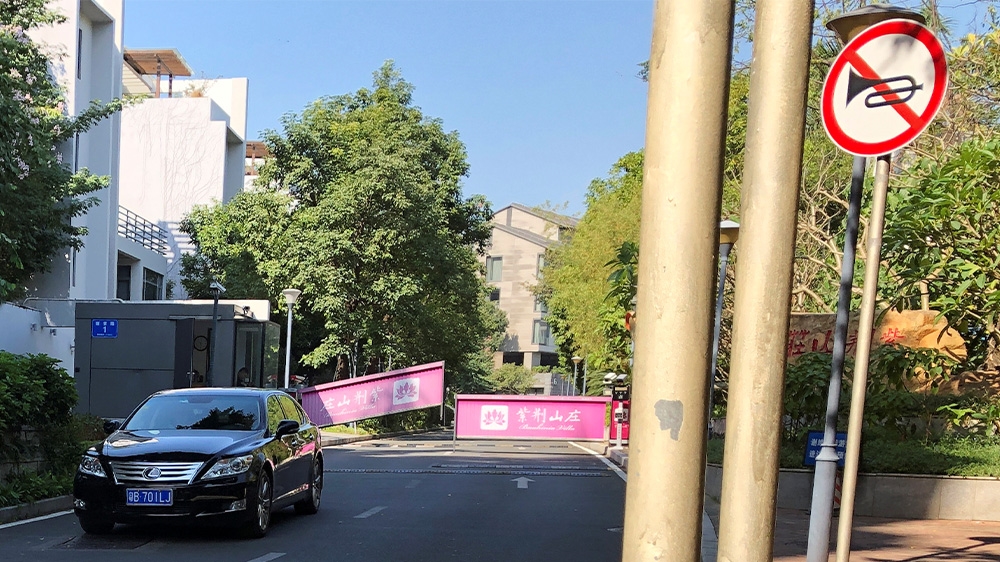China considers replacing top Hong Kong liaison officer: report
China tightening control over its response to Hong Kong from crisis command centre across the border in Shenzhen villa.

China’s leadership is considering replacing its most senior liaison official in Hong Kong and has set up a crisis command centre in the southern border city of Shenzhen to tighten control over efforts to manage the upheaval in the self-governing Chinese territory.
Ordinarily, communications between Beijing and Hong Kong are conducted through a Chinese government body: the Liaison Office of the Central People’s Government in Hong Kong.
Keep reading
list of 2 itemsHong Kong pro-democracy movement scores landslide win
The Liaison Office is housed in a Hong Kong skyscraper stacked with surveillance cameras, ringed by steel barricades and topped by a reinforced glass globe.
But the mainland’s leaders have been managing their response from a villa on the outskirts of Shenzhen, bypassing the formal bureaucracy, and is considering potential replacements for the agency’s director, Wang Zhimin, two people familiar with the situation told Reuters.
Wang is the most senior mainland political official stationed in Hong Kong.
The office has come in for criticism in Hong Kong and China for misjudging the situation in the city.
“The Liaison Office has been mingling with the rich people and mainland elites in the city and isolated itself from the people,” a Chinese official told Reuters. “This needs to be changed.”

The Liaison Office may face increased pressure after city voters delivered a resounding defeat to pro-Beijing parties in local district elections on Sunday. Pro-democracy candidates won more than 80 percent of the seats, securing their first-ever majority after running a campaign against Beijing’s perceived encroachments on Hong Kong’s liberties.
The State Council’s Hong Kong and Macau Affairs Office and the Liaison Office in Hong Kong did not reply to faxed requests for comment.
The office of Hong Kong Chief Executive Carrie Lam declined to comment.
‘Frontline command centre’
The crisis centre is located at the secluded Bauhinia Villa, a property owned by the Hong Kong Liaison Office, according to sources and official media, and named after the orchid that adorns the Hong Kong flag and currency.
The villa, located just across Hong Kong’s border with the mainland, has served as a crisis centre before when senior Chinese officials stayed at the resort during the pro-democracy “Occupy Central” protests that rocked Hong Kong in 2014.
Top mainland officials have been gathering at the leafy compound to plot strategy and issue instructions aimed at defusing the crisis, according to six people familiar with the matter. Beijing authorities have been summoning key Hong Kong officials to meet at the villa during the five months of the increasingly violent anti-government protests, the sources said.

Among those who have attended, two of the people said, is embattled city leader Carrie Lam, who in September dramatically scrapped the controversial extradition bill that had ignited the protests, with the backing of China’s top leadership.
Hong Kong police officials, business leaders and local pro-Beijing politicians have also been summoned to the villa.
In an indication of the operation’s importance, Chinese President Xi Jinping is receiving daily written briefings from Bauhinia Villa, said two officials and another person familiar with the operation.
The mainland Chinese and Hong Kong officials interviewed for this article spoke to Reuters on condition of anonymity, citing the sensitivity of the matter.
A Shenzhen businessman with close ties to Chinese officials described the villa complex as a “front-line command centre” that authorities are using as a base for coordinating and monitoring the Hong Kong situation in a secure environment. The complex is “packed with people,” the businessman said.
The establishment of the Shenzhen villa as a crisis centre with a channel to top leader Xi points to the gravity and delicacy of the situation in Hong Kong, diplomats said.
Mass protests erupted in June over an extradition bill that would have allowed individuals to be sent for trial to the mainland, but have since evolved into broader calls for democracy and an inquiry into alleged police brutality. Beijing wants to restore order in the city, but without being seen to be calling the shots.
|
|
Hong Kong is governed under a charter which grants British-style rule of law until 2047, and its high degree of autonomy is widely seen as key to its success as an international financial centre.
City and mainland officials say the police response has been measured and that any violence has been initiated by extreme protesters.
‘Parallel headquarters’
The use of Bauhinia Villa to manage the crisis sets up a supplementary channel to the system Beijing put in place to oversee Hong Kong after China regained control of the city from Britain in 1997.
The Liaison Office, which reports to China’s State Council, has long served as the platform for Beijing to expand its influence in the city. The office fosters relationships with the Hong Kong government as well as establishment figures and an array of pro-Beijing and youth groups, including business and clan associations from Chinese provinces and regions.
“The Hong Kong situation has increasingly made Beijing authorities uncomfortable,” said Sonny Lo, a veteran Hong Kong political commentator. Their desire for security and discretion, he said, is “the reason they select Shenzhen rather than Hong Kong as a kind of parallel headquarters in dealing with the Hong Kong crisis.”

Senior Chinese officials initially tried to find a middle ground between not capitulating to the demands of the protesters and trying to avoid a bloody crackdown that could damage the city’s reputation, according to three of the people familiar with the Bauhinia operation.
Beijing sought to give the impression it was not intervening in Hong Kong even after a million people took to the streets on June 9, the people said.
Shortly after that show of mass defiance, however, the most senior Chinese leader in charge of Hong Kong affairs took action. That official, Vice Premier Han Zheng, authorised Lam to communicate directly with his office, rather than going through the Liaison Office, according to a person briefed on the matter, effectively establishing a hotline.
Subsequently, vice minister-level officials with China’s Ministry of Public Security, Ministry of State Security, the Cyberspace Administration of China and other departments all visited the villa, three of the sources said, an indication of just how seriously Beijing took the situation.
The two most senior Chinese leaders overseeing Hong Kong have been using Bauhinia Villa to deal more closely with the local leaders of the restive city while remaining behind the scenes.
One is Zhang Xiaoming, the head of the Hong Kong and Macau Affairs Office, which sits under China’s top policy-making body, the State Council. He has been a regular presence at the villa during the crisis, according to two sources who met with him there.
A third person who met Zhang at Bauhinia Villa said Zhang spoke in detail about the now-shelved extradition bill and its importance, as well as subsequent attempts by Beijing to quell the unrest.
The other is Vice Premier Han himself. A day after Hong Kong protesters blocked access to the city’s legislature on June 12, Han arrived at Bauhinia Villa and summoned Lam for a meeting, according to a person briefed on their discussions. Gathered at Bauhinia was a multi-departmental team of Chinese public security, cybersecurity and intelligence officers, as well as advisers on Hong Kong affairs, three sources said.
|
|
When Lam proposed a suspension of the bill at that meeting, Han agreed after talking to other leaders in Beijing, the person briefed on the meeting said. Lam then announced the suspension of the bill on June 15.
The Liaison Office and senior pro-Beijing politicians in the city “didn’t know about the withdrawal until close to the decision,” a senior Hong Kong official said.
Trees and barbed wire
The concession did not placate the protesters who demanded a full and formal scrapping of the bill.
As the protests have persisted, Beijing has taken a more visible role in Hong Kong: Chinese aviation authorities called for Hong Kong’s Cathay Pacific Airways to suspend staff who supported or participated in the demonstrations, mainland paramilitary forces conducted exercises openly just across the border in Shenzhen, and China last week criticised a Hong Kong court ruling that overturned the city’s ban on face masks used by protesters, rare interference in the territory’s judiciary.
Bauhinia Villa has long been an outpost for mainland China’s dealings with Hong Kong.
In addition to serving as a crisis centre during the 2014 protests, the villa has been used as a low-key venue for Chinese officials to meet city figures, with lodging facilities and ample space for conferences and events.
Bauhinia Villa also has hosted delegations from the Hong Kong pro-establishment and pro-Beijing camps for training sessions and preparatory meetings before annual legislative sessions in Beijing.
Security is tight, with checkpoints, spiked fences topped with barbed wire and numerous surveillance cameras. At the back is a steep tree-covered hill ringed with fencing, while on another side lies a conference centre. A Reuters journalist was turned away recently when he approached the property.